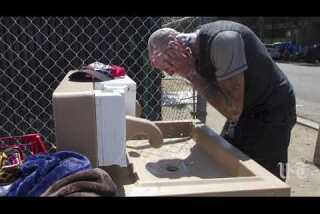Sharp to lead international study on umbilical cords

- Share via
Sharp HealthCare will lead an international research effort to better understand how a technique called umbilical cord milking benefits premature babies.
The study, which seeks to enroll 1,500 newborns across nine sites, is the latest example of medicine’s rapidly evolving approach to the first few minutes after a baby’s delivery. For decades, the standard practice was to clamp and cut the cord very quickly following birth. Now, science has increasingly shown that such action cuts off a beneficial blood supply rich in stem cells, oxygen-transporting hemoglobin and iron, all of which can benefit childhood development.
Announcement of the Sharp-led project comes just a week after the American Congress of Obstetricians and Gynecologists finalized a new recommendation that doctors wait at least 30 to 60 seconds before clamping a newborn’s umbilical cord, allowing more time for blood remaining in the placenta to move from mother to baby. A similar recommendation was already in place for premature infants, and the organization’s latest guidelines extend that guidance to babies carried to term.
But the new guidance stops shy of recommending cord milking, a procedure that involves health providers squeezing the umbilical cord with their fingers while moving their hand from the mother toward the baby — a motion that pushes blood through the cord like squeezing toothpaste in a tube. The entire procedure takes 10 to 15 seconds.
The latest guidelines from the OB/GYN association found that umbilical cord milking needs more research before it can be endorsed as part of standard care. In the meantime, doctors, midwives and others are free to perform the maneuver if they feel it is warranted.
Dr. Anup Katheria, director of neonatal research at Sharp Mary Birch and principal investigator of the milking study, said the main goal is to show that milking compares favorably to delayed clamping in infants born more than eight weeks before their due date.
“We want to show that it reduces death and reduces brain bleeding in premature babies,” Katheria said.
On a recent morning at Sharp Mary Birch, Krystina Mixon said she decided to allow cord milking to take place after her C-section to deliver her son, Phillip. She had heard about the procedure in a labor and delivery class, then followed up with online research. She liked the idea that her newborn might get a little extra shot of helpful substances right at the start of his life.
“Whatever is best for my baby, that’s my main concern,” she said.
The Sharp-led study is funded by a $2.9 million, five-year grant from the National Institutes of Health. It will randomly assign premature babies delivered vaginally or through cesarean section to receive delayed cord clamping or cord milking, and researchers will follow up when the child turns 2 years old to determine whether there have been any differences in development.
“Both of these procedures are going to give the baby (some umbilical cord) blood. We’re just studying which one might be a little bit better,” Katheria said.
The benefits of infusing more cord blood after birth are now widely accepted, said Dr. Maria Mascola, lead author of the OB/GYN association’s newly released recommendation on delayed cord clamping. Studies have shown clearly that premature babies get the most benefit, she said. Those that receive delayed cord clamping develop fewer cases of brain bleeding, experience less intestinal inflammation and have reduced need for blood transfusions.
The benefits are more subtle in full-term babies, Mascola added. Still, even in those infants, higher blood counts and iron stores are believed to convey genuine developmental benefits.
“It might not seem like that big of a deal, but young children and infants rely heavily on iron levels and normal blood counts for their cognitive development,” Mascola said.
While some studies on cord milking — such as a smaller pilot investigation published in 2015 by Katheria and other researchers — have shown similar gains, the body of evidence is not yet as large. That makes the new study exciting, Mascola said.
“It’s going to answer a lot of questions, and I look forward to the results,” she said.
One significant issue with past cord milking studies was that each group of researchers milked in a different way. Some would slide along the entire cord once while others would repeatedly squeeze a shorter section. The Sharp study asks all participants to use the same motion — grasping the cord gently with the thumb and forefinger and sliding toward the baby for two seconds. The motion is to be repeated a total of four times.
Katheria believes delayed clamping works well for babies born the traditional way. When a cesarean section is required, which is often the case for premature infants, blood flow may be less robust.
“The uterus no longer functions as a sort of vice on the placenta, squeezing it to allow blood through. This, in my mind, limits the effectiveness of delayed cord clamping,” Katheria said.
Whatever the method used, can a newborn get too much blood through the umbilical cord?
Katheria said he has no concerns in this regard. Placental blood, he noted, is always the baby’s own supply moving back and forth across the umbilical cord to collect nutrients from the mother’s blood supply, which is separated by the placenta.
“It is all their own blood, so there is no risk of ‘over-transfusion,’” Katheria said. “A premature baby leaves behind about 50 percent of the blood in the placenta. A full-term baby leaves about 20 percent.”
Mascola said a vital question that could be answered by the new study is whether any differences result from the rapid blood-volume changes caused by cord milking compared to the slightly more gradual changes created by delayed clamping.
“The small studies so far are encouraging and do not find this to be a problem, but more research is needed to look at this question in larger numbers of newborns,” Mascola said.
It is important to understand that the new project’s main endeavor is to determine whether cord milking is as safe as delayed clamping, said Dr. Balaji Govindaswami, chief of the division of neonatology at Santa Clara Valley Medical Center in San Jose. He said the secondary goal of comparing children at 2 years of age, while interesting, would likely require further research to achieve sufficient validity.
There is much value in understanding whether cord milking and delayed clamping are equally safe, he concluded. After all, 15 percent to 20 percent of babies are born with an immediate problem, like a need for immediate resuscitation, that can’t wait a minute for medical intervention. In such scenarios, cord milking could prove to be more helpful than delayed clamping.
Health Playlist


Video: Leaders urge public to help extinguish hepatitis outbreak

San Diego starts cleansing sidewalks, streets to combat hepatitis A

Video: Scripps to shutter its hospice service

Video: Scripps La Jolla hospitals nab top local spot in annual hospital rankings

Video: Does a parent's Alzheimer's doom their children?

EpiPen recall expands

Kids can add years to your life
paul.sisson@sduniountribune.com
(619) 293-1850
Twitter: @paulsisson
More to Read
Sign up for Essential California
The most important California stories and recommendations in your inbox every morning.
You may occasionally receive promotional content from the Los Angeles Times.












